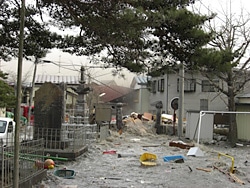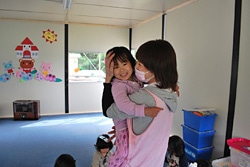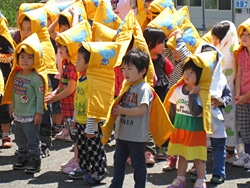



[TOKYO, JAPAN, 6 February 2013]
The coastal areas of Iwate Prefecture were heavily damaged in the Great East Japan Earthquake. At the instant the earthquake struck, some 350 nursery centres in the prefecture were responsible for the well-being of nearly 20,000 children. Nevertheless, amidst a situation where an unprecedented disaster created a need for extraordinary response, children and staff of nursery facilities in Iwate Prefectures were able to escape danger unscathed due to regular disaster-preparedness drills and appropriate decision-making and flexible response by nursery staff.
The Japan Committee for UNICEF (JCU) and the Child and Families Section of the Iwate Prefecture Government (Health and Welfare Division) conducted a collaborative survey of nursery centres across the prefecture with the objective of utilizing experiences and lessons learned to strengthen disaster response measures at nursery care facilities. JCU also jointly released a report on evacuation efforts taken by each nursery centre at the time of the disaster. The report is entitled "Evacuation Records of Nursery Centres in Iwate Prefecture: Preschools protecting children on 11 March".
For the survey, questionnaires were distributed to all nursery centres in Iwate Prefecture, including those located at inland areas. Responses were received from 75% of the centres contacted. Interviews were also conducted at nursery centres located at coastal areas in order to more precisely document the actions of staff following the earthquake. The report revealed the heroic stories of many nursery staff to protect children during the emergency that before the survey remained untold. There were stories of staff carrying children on their backs and leading them by the hand through devastated roadways to highland areas to seek refuge from the tsunami. There were stories of remarkable cooperation and partnerships among local residents, fire departments and others. There were even stories of desperate efforts to restart nursery classes at a time when the ability to reestablish lifelines was even questionable. The report also served as an opportunity to verify how daily preparations and trainings were put to use during the emergency, shedding light on the importance and future challenges of evacuation training and disaster-preparedness measures.
 |
| Photo provided by a nursery centre in Yamada Town. |
| The tsunami entering the schoolyard. |
Chiharu Kondo served as the Iwate Field Manager of the JCU Great East Japan Earthquake Emergency Assistance Headquarters until March 2012 and as a research consultant overseeing the survey and subsequent analysis on this occasion. Ms. Kondo spoke about the survey:
"In talks with staff at the Iwate Prefectural Government Child and Families Section we learned that in Iwate Prefecture no child present at a prefectural nursery centre was hurt during the Great East Japan Earthquake, and that that was the result of regular evacuation training drills. This survey was implemented in order to officially record some of the experiences at nursery centres during the disaster and use that data to improve disaster-preparedness measures moving forward.
 |
| ©.Japan Committee for UNICEF /K.Goto |
| Nursery staff hugging a student after classes reopened. |
"The survey was conducted between March and April 2012, roughly one year following the Great East Japan Earthquake. Nursery centre staff who participated in the survey thus had to think back to their experiences from the day of the disaster, but several participants noted that the survey was actually the first time they really reflected on the evacuation process or had the opportunity to discuss the events of the disaster in detail. We received completed questionnaires and free responses from 263 of the 353 nursery centres in Iwate Prefecture, some of which delved into the finer details of the situation at the time of the disaster and during evacuation. I would like to take this opportunity to again extend my gratitude to everyone who took the time to participate in the survey.
"This survey revealed that the same nursery staff responsible for taking care of children during normal times continued their services following the disaster, paying significant thought to their responsibility to look after and protect the children. It brings me great pleasure to record and share this with others.
 |
| Photo provided by a nursery centre in Otsuchi Town. |
| A regular evacuation training drill. |
"In recent years, greater emphasis has been placed on disaster-preparedness measures in Japan and abroad due to the rising number of natural disasters. In particular, disaster-preparedness measures will grow in importance as a priority issue at nursery and educational facilities in charge of young children. I strongly hope that this record will be a helpful reference for people involved in nursery care and child education not only in Iwate Prefecture, but across Japan and in other countries."
There are now plans to distribute the "Evacuation Records of Nursery Centres in Iwate Prefecture" report to nursery centres and municipal governments in Iwate and other prefectures. The Japan Committee for UNICEF is also planning the preparation of a English version of the report (pdf only).